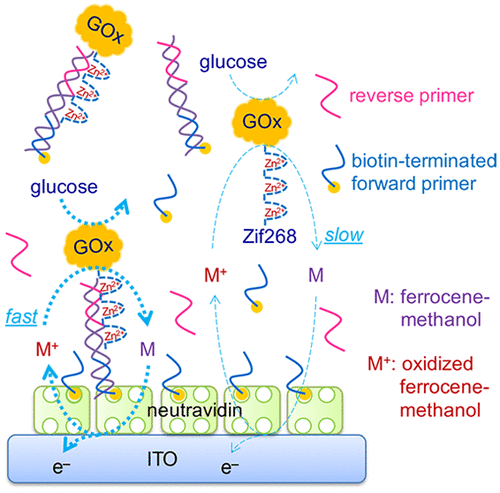当前位置:
X-MOL 学术
›
Anal. Chem.
›
论文详情
Our official English website, www.x-mol.net, welcomes your
feedback! (Note: you will need to create a separate account there.)
Washing-Free Electrochemical Detection of Amplified Double-Stranded DNAs Using a Zinc Finger Protein
Analytical Chemistry ( IF 6.7 ) Pub Date : 2018-03-19 00:00:00 , DOI: 10.1021/acs.analchem.8b00143 Chiew San Fang 1 , Kwang-sun Kim 1 , Dat Thinh Ha 2 , Moon-Soo Kim 2 , Haesik Yang 1
Analytical Chemistry ( IF 6.7 ) Pub Date : 2018-03-19 00:00:00 , DOI: 10.1021/acs.analchem.8b00143 Chiew San Fang 1 , Kwang-sun Kim 1 , Dat Thinh Ha 2 , Moon-Soo Kim 2 , Haesik Yang 1
Affiliation

|
Recombinase polymerase amplification (RPA) has been combined with electrochemical detection for simple and rapid point-of-care testing. However, there are two major hindrances to this simple and rapid testing: (i) washing or purification steps are required to remove unbound labeled probes and interfering species in the sample; (ii) it is difficult to quantify double-stranded DNA (dsDNA) electrochemically by using biospecific affinity binding without dsDNA denaturation. In the present study, we describe a wash-free and rapid electrochemical method to detect RPA-amplified dsDNAs using a zinc finger protein, Zif268. Electrochemical detection is achieved using proximity-dependent electron mediation of ferrocenemethanol between a glucose-oxidase (GOx) label and an electrode, which differentiates the specifically electrode-bound and -unbound labels without a washing or purification step. RPA-amplified dsDNA containing a biotin-terminated forward primer is specifically bound to a neutravidin-modified electrode, and GOx-conjugated Zif268 is specifically bound to the dsDNA. The whole detection is performed within 17 min (15 min for the RPA reaction and <2 min for the electrochemical measurement). Electrochemical detection is carried out without an additional incubation period, because the specific binding between Zif268 and the dsDNA occurs during the RPA reaction. The detection method could discriminate between target template DNA of Piscirickettsia salmonis and nontarget DNAs (random sequence and calf thymus DNA). The detection limit for the target DNA is approximately 300 copies in 13.2 μL, indicating that the detection method is ultrasensitive. We believe that the method could offer a promising solution for simple and rapid point-of-care testing.
中文翻译:

使用锌指蛋白的免洗电化学检测扩增的双链DNA
重组酶聚合酶扩增(RPA)已与电化学检测相结合,可进行快速简便的即时检测。但是,这种简单而快速的测试有两个主要障碍:(i)需要洗涤或纯化步骤以去除样品中未结合的标记探针和干扰物质;(ii)难以通过使用生物特异性亲和力结合而不进行dsDNA变性的方法来电化学定量双链DNA(dsDNA)。在本研究中,我们描述了一种免洗快速电化学方法,可使用锌指蛋白Zif268检测RPA扩增的dsDNA。使用二茂铁甲醇在葡萄糖氧化酶(GOx)标记和电极之间的接近依赖性电子介导可以实现电化学检测,无需清洗或纯化步骤即可区分特定的电极结合和非结合标记。含有生物素终止的正向引物的RPA扩增dsDNA特异性结合到中性亲和素修饰的电极上,GOx缀合的Zif268特异性结合到dsDNA。整个检测在17分钟内进行(RPA反应15分钟,电化学测量<2分钟)。电化学检测无需额外的孵育时间,因为Zif268和dsDNA之间的特异性结合是在RPA反应过程中发生的。该检测方法可以区分靶基因的DNA模板。结合了GOx的Zif268与dsDNA特异性结合。整个检测在17分钟内进行(RPA反应15分钟,电化学测量<2分钟)。电化学检测无需额外的孵育时间,因为Zif268和dsDNA之间的特异性结合是在RPA反应过程中发生的。该检测方法可以区分靶基因的DNA模板。结合了GOx的Zif268与dsDNA特异性结合。整个检测在17分钟内进行(RPA反应15分钟,电化学测量<2分钟)。电化学检测无需额外的孵育时间,因为Zif268和dsDNA之间的特异性结合是在RPA反应过程中发生的。该检测方法可以区分靶基因的DNA模板。鲑鱼立克次氏体和非靶DNA(随机序列和小牛胸腺DNA)。目标DNA的检出限为13.2μL,约为300个拷贝,表明该检测方法是超灵敏的。我们认为,该方法可以为简单,快速的即时检验提供有希望的解决方案。
更新日期:2018-03-19
中文翻译:

使用锌指蛋白的免洗电化学检测扩增的双链DNA
重组酶聚合酶扩增(RPA)已与电化学检测相结合,可进行快速简便的即时检测。但是,这种简单而快速的测试有两个主要障碍:(i)需要洗涤或纯化步骤以去除样品中未结合的标记探针和干扰物质;(ii)难以通过使用生物特异性亲和力结合而不进行dsDNA变性的方法来电化学定量双链DNA(dsDNA)。在本研究中,我们描述了一种免洗快速电化学方法,可使用锌指蛋白Zif268检测RPA扩增的dsDNA。使用二茂铁甲醇在葡萄糖氧化酶(GOx)标记和电极之间的接近依赖性电子介导可以实现电化学检测,无需清洗或纯化步骤即可区分特定的电极结合和非结合标记。含有生物素终止的正向引物的RPA扩增dsDNA特异性结合到中性亲和素修饰的电极上,GOx缀合的Zif268特异性结合到dsDNA。整个检测在17分钟内进行(RPA反应15分钟,电化学测量<2分钟)。电化学检测无需额外的孵育时间,因为Zif268和dsDNA之间的特异性结合是在RPA反应过程中发生的。该检测方法可以区分靶基因的DNA模板。结合了GOx的Zif268与dsDNA特异性结合。整个检测在17分钟内进行(RPA反应15分钟,电化学测量<2分钟)。电化学检测无需额外的孵育时间,因为Zif268和dsDNA之间的特异性结合是在RPA反应过程中发生的。该检测方法可以区分靶基因的DNA模板。结合了GOx的Zif268与dsDNA特异性结合。整个检测在17分钟内进行(RPA反应15分钟,电化学测量<2分钟)。电化学检测无需额外的孵育时间,因为Zif268和dsDNA之间的特异性结合是在RPA反应过程中发生的。该检测方法可以区分靶基因的DNA模板。鲑鱼立克次氏体和非靶DNA(随机序列和小牛胸腺DNA)。目标DNA的检出限为13.2μL,约为300个拷贝,表明该检测方法是超灵敏的。我们认为,该方法可以为简单,快速的即时检验提供有希望的解决方案。











































 京公网安备 11010802027423号
京公网安备 11010802027423号